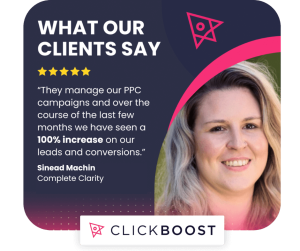-
Services

Paid Ads

Social Ads




Notice how you can get information relating to the search terms your competitor is showing for, the average position, traffic data and cost estimates.
If you want to test this report yourself simply click here to sign up for a free trial or enter a URL in the box below to test.

It goes without saying that the above report can quickly help you discover gaps in your competitor’s organic and paid search strategy.
As well as being able to carry out a gap analysis, you can also quickly view organic rankings for any website by entering a URL below.
There’s a handy little scraper extension for Google Chrome that allows you to scrape all kinds of information from a website quickly and easily. I have used this in the past to help e-commerce businesses to find new brands/products to sell on their website. Here’s how it’s done….
Simply navigate to a competitor’s website and locate where a list of the brands they sell are listed. In this case, I tried it out on the Halfords exercise bike page.

What I like to do at this point is to modify the keywords by appending additional information to them. In this example, I will add the word ‘bikes’ to make the data more specific. This can be done easily by dropping the information into Excel or Google Docs and using a simple formula such as =A1&” bikes” (assuming the first bike brand is in cell A1).

Right-click information that is similar to what you want to scrape and then click ‘scrape similar’.
The information is then displayed within the Scraper interface and can be either copied to your clipboard or you can export it to Google docs as can be seen below.

From there simply drop the information into the SEMrush keyword difficulty tool and from there you’ll be able to get search volume data for each brand as you will see below. I have highlighted average monthly search volume information using a red box.


Businesses will also have a development website that they forget to hide from Google. This can be a great way to find out what functionality a competitor is planning on launching in the near future. Sometimes they even test promos on these sites before pushing them live.
To find these sites simply go to Google and type site:ClientsDomaindName.com -site:www.ClientsDomaindName.com. What this does is show you all the indexed website addresses that do not contain www.
Often you’ll find that a client may have a development site sitting on a url such as staging.ClientsDomaindName.com which should flag up using the aforementioned search query.
Display remarketing is one of the best forms of display advertising as it allows you to show ads to people that have shown an interest in your product or service. Often businesses will incentivise previous visitors with special offers and discount codes if they feel a previous visitor has a high propensity to convert.
Using SEMrush you can have a look at the display campaigns being run by your competitors to find out how they are incentivising people to visit/revisit their website on the display network.
This information can be extremely useful as you can use it to make sure you have far better display ads and competitive offers.
Simply drop a competitor’s URL into Buzzsumo and you will be presented with a sortable list of content from your competitor’s website that produced lots of Facebook engagements, Twitter Shares and volume of backlinks.
When you find a piece of content that performed well, you can then use the Skyscraper technique to produce your own, better version of the content. The Skyscraper technique is one of the best link acquisition methods that I’ve used and it can really help transform your content marketing efforts, and in turn, your search presence.
Brian Dean from Backlinko explains this perfectly in the video below, make sure you check it out.
Ghostery is a nifty tool created to block trackers from snooping on your web activity. What it also does is display a list of said trackers. This precious data can give you information about which advertising platforms your competitors use.

With this knowledge, you can stay ahead of them by not missing out on any potential ad avenues.
How cool would it be to get access to a competitor’s Google Analytics account to understand which products are selling well online? Unfortunately, most people will not have that luxury but this strategy may just be the next best thing.
We can use Screaming Frog, a product that every digital marketer should have in their arsenal, to crawl a competitors website & find products with the highest volume of reviews. This information alone will give you a good insight into relative sales volume for any given product on their website.
If you take the review information and combine it with search volume data in a similar way as can be seen in tactic #3, it will allow you to understand which products have a high demand as a large volume of reviews combined with a high number of searches indicate that people are probably buying that product. This is a fantastic tactic for any affiliate marketer, business owner, or product buyer as it allows them to gauge the popularity of a product before they list it on their website.
Simply head over to a competitor website and find where their reviews are located and right click the element that shows the volume of reviews and click inspect. This will open the inspect element section of Google Chrome. After that simply find the review text within the code, right click it, select copy and then click copy selector. I have used Amazon below as an example.

Once you have copied the selector, simply open Screaming Frog and navigate to configuration > custom > extraction and paste the selector that you have copied. Following that, you simply have to run a crawl of the competitor’s site and the review volume will be extracted from the page.
There’s a free tool called Facebook Ad Library that very few people are aware of or actually utilise. Facebook Ad Library allows you to enter a competitors name and see all of the Facebook Ads they are running.
This can be an incredibly powerful way to understand how competing busineses are promoting themselves via Facebook Ads.
Bonus Tip: Look for ads that have been active for the longest period of time as this often indicates that the ads are successful, try taking inspiration from these ads and see how they perform for you.
24. OFFER A MUCH BETTER CUSTOMER EXPERIENCE, GET BETTER REVIEWS AND BE AWESOME
I know this last point will seem a bit wishy-washy to some, but offering a better customer experience and getting better reviews will normally increase the chances that you will do better than your competitors.
Analyse what they’re doing better than you. Do they offer faster delivery? Do they have better customer service? Are they getting more positive reviews? Once you find all this out you need to simply do it better.
I’ve worked on projects in the past that showed a strong correlation between the volume of top 10 negative reviews on TrustPilot and a website’s conversion rate.
Sure there are tricks to game online reviews such as making sure you only send review requests to customers that received a great service from you, but every business that I have worked with that genuinely focuses on offering a great customer experience are the ones that do well in the long term.
Links To Tools Mentioned In This Blog Post:
SEMrush (Free Trial)
Ahrefs
Scrape Similar


